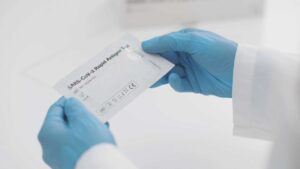
On Monday, I received the phone call that every mother of a little child dreads: my son had been sent home from nursery due to a cough and would need to undergo COVID rapid antigen tests before he could be allowed back.
As we noted in our piece on the difficulties of taking COVID exams while being a working mother, this is a circumstance that will recur time and time again as the winter months approach and your child begins to interact with other children at his or her nursery.
I was obviously concerned about him, but since he seemed to be in good health and did not appear to be suffering from a fever, I was also concerned that the findings would take an inordinate amount of time to come back. Let’s be honest: nursery is EXTREMELY EXPENSIVE, and the stress of being a self-employed mother isn’t really enjoyable.
Fortunately, I was able to get a rapid antigen test scheduled for that day on the website right quickly (tip: I’ve heard they are posted at 8 pm and 8 am each day, so it’s worth refreshing then if there aren’t any available in your location) and had the results in little over 24 hours. Check out some risks related to the RAT test at https://davidsnieckus.com/risks-about-rapid-antigen-tests/
I was apprehensive about bringing my kid for his first COVID rapid antigen tests—which, happily, came out negative—and I thought I’d share my top advice with you in case you’re taking a COVID rapid antigen test with a little child for the first time as well.
1. If possible, bring a second person with you.
Although I do not recommend bringing a group of people to the testing center, if you have someone in your household who can assist, it will make the process much easier. You will need to park your vehicle, clamber into the back seat without exiting your vehicle, attempt to swab, and then climb back into your vehicle with the swab in hand (while making sure it does not touch anything!) It’s considerably simpler if you have someone in the rear who can hold their hand or distract them while you’re working.
2. It is not necessary to swab the tonsils.
While I was attempting to access my son’s tonsils, the attendant kindly informed me that children under the age of 12 just only had a single nose swab, which is clearly MUCH simpler!
Obviously, double-check with your center to see what their criteria are, but we were just required to insert the swab under one nose in our case.

3. Bring snacks with you.
Because the area wasn’t very well signposted, we needed plenty of snacks while we attempted to locate the testing center. After that, you’ll need peace and quiet for a few minutes while you read the instructions carefully (which is why having a helper is so helpful), as well as something to keep you entertained while you’re trying to seal the bottle. If you have more than one child, this is much more important.
4. Bring a tablet computer.
It might also be anything to keep their focus away from the fact that you’re poking them in the nose with a stick in general. Thank you, five tiny ducks, for assisting us in getting through this difficult time! Anyone else’s toddler despises anything that comes into contact with their nose?
5. You are not required to show identification.
When you arrange the rapid antigen tests, you’ll be asked to bring your child’s picture identification with you: cue the worry and searching since Jude doesn’t have a passport! Fortunately, they just ask for the QR code when you arrive and did not ask for any other identification (at least not from me or Jude), so don’t be concerned if your child does not have one. visiting the lab for a test, you may need some extra gears like face masks, sanitizers, etc, which you can easily buy online from https://clinicalsupplies.com.au
6. Don’t forget to bring wipes and hand sanitizer.
Asking your kid to blow their nose is another irritating command that does not apply to newborns and toddlers.
Jude, on the other hand, was not going to allow that to happen, so I just cleaned around his nasal region before I started. It is also recommended that you bring your own hand sanitizer so that you may sanitize your hands before returning the switch to the tester.
7. If you are evaluating more than one child, snap a picture of the area where they were seated.
So many individuals have reported having their exams mixed up, so make a note of who is seated there before giving the tests back into the testing center. They do provide you with a card to use to indicate where people are sitting in your vehicle, but I found it to be really confusing, so it may be worthwhile to take a picture of it as well.
Incredibly, rapid antigen tests results were returned in less than 24 hours and were negative, allowing my kid to return to nursery today (I’m not sure whether he has a chest infection, so I’m contemplating calling the doctor tomorrow). Please share your thoughts and experiences: Have you ever had to take your infant or toddler to the doctor for rapid antigen tests? How did it go?
What comes next?
A Faint Line Is Still a Line
The presence of even a thin line should be considered good, according to Johns, particularly in the case of those who are experiencing symptoms. Contact your local health department as soon as you see even the slightest suggestion of a line so that they can record your result for official tallies and offer up-to-date information on how you can isolate yourself. In addition to providing local health authorities with a more accurate picture of how widespread COVID is in your region, this step also helps reduce the chance of COVID spreading farther afield.


